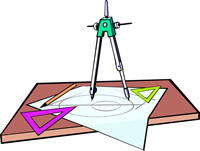|
|
In relation to Geometry, the term "construction" refers to the drawing of geometric figures using only a compass and a straightedge (an unmarked ruler). An amazingly large number of constructions can be made using only this minimal set of tools. |
|
The Greek mathematician, Euclid c. 300 BC, wrote a famous mathematical textbook on geometry called "The Elements". In his book, Euclid often explained how to construct a figure before he would discuss properties and theorems surrounding that figure. He saw a connection between how a shape was constructed and what could be known about that shape. This connection would prove to be one of the stabilizing features about geometry by reinforcing geometric truths.
As Euclid discovered, the beauty of a construction is that the relationship it portrays can be supported by a formal proof. Once a construction is drawn, a geometric proof can be supplied to show that the construction actually behaves as expected. You can think of constructions as physical verifications of geometric concepts.

|
 Basic Constructions: |
There are six constructions that are usually considered the Basic Constructions as they are used in the creation of the other constructions. These are your building blocks. You need to know how to draw these constructions.
• Copy a segment
• Copy an angle
• Bisect a segment (Create a perpendicular bisector of a segment)
• Bisect an angle
• Construct a perpendicular to a given line from a given point on the line
• Construct a perpendicular to a given line from a given point not on the line.

 Required Constructions: |
The constructions listed below are stated "by name" in the NY Next Generation Mathematics Standards (NGMS), making them important constructions. While it is essential to know how to develop these specific constructions, it is also important to know how to use these constructions to produce other diagrams illustrating (or supporting) geometric definitions and concepts. In other words, you need to be able to apply these construction skills to new situations and to the development of new constructions.
 NGMS states: "Examples of constructions include but are not limited to:" NGMS states: "Examples of constructions include but are not limited to:"

While the NGMS "Plus (+) Standards" will not be tested on state examinations, it is suggested that they be dispersed throughout course curricula, including Algebra 1, Algebra 2, and Geometry, to increase rigor and support the needs of individual students and mathematical programs.
(Quote: "The Plus (+) Standards are not a high school course.")
One of the "Plus (+) Standards" with coherence in Geometry is the construction G.C.4.
 Coherence: Geo.G.C.2b to (+) G.C.4 Coherence: Geo.G.C.2b to (+) G.C.4
• G.C.4: Construct a tangent line from a point outside a given circle to the circle.
|

FYI: Impossible Constructions: |
There are three famous constructions that are not possible using only a straightedge and compass:
• trisecting an angle
(given an angle, construct an angle whose measure is exactly one-third of the given angle)
•
squaring a circle
(construct a square that has exactly the same area as a circle)
• doubling a cube
(given the side of a cube, construct a side length for a cube that will have exactly double the area of the given cube)

NOTE: The re-posting of materials (in part or whole) from this site to the Internet
is copyright violation
and is not considered "fair use" for educators. Please read the "Terms of Use". |
|

